
Quainton Road railway station was opened in 1868 in under-developed countryside near Quainton, in the English county of Buckinghamshire, 44 miles (71 km) from London. Built by the Aylesbury and Buckingham Railway, it was the result of pressure from the 3rd Duke of Buckingham to route the railway near his home at Wotton House and to open a railway station at the nearest point to it. Serving a relatively underpopulated area, Quainton Road was a crude railway station, described as "extremely primitive".
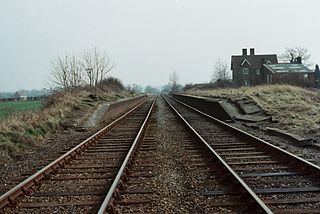
Verney Junction railway station was an isolated railway station at a four-way railway junction in Buckinghamshire, open from 1868 to 1968; a junction existed at the site without a station from 1851.

Aylesbury railway station is a railway station in Aylesbury, Buckinghamshire, England, on the London–Aylesbury line from London Marylebone via Amersham. It is 38 miles (61 km) from Aylesbury to Marylebone. A branch line from Princes Risborough on the Chiltern Main Line terminates at the station. It was the terminus for London Underground's Metropolitan line until the service was cut back to Amersham in 1961. The station was also known as Aylesbury Town under the management of British Railways from c. 1948 until the 1960s.

The Varsity Line was the main railway line that linked the English university cities of Oxford and Cambridge, operated by the London and North Western Railway.
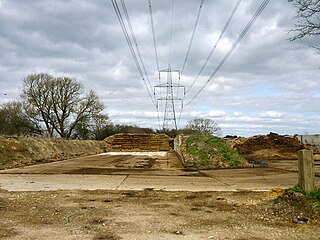
Granborough Road railway station was a station serving the village of Granborough, to the north of Quainton in Buckinghamshire, England.
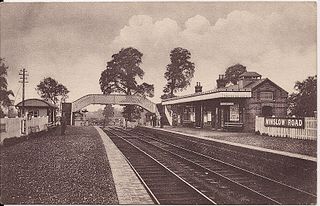
Winslow Road railway station served the village of East Claydon near Winslow to the north of Quainton in Buckinghamshire, England. It was the second station to serve the town after Winslow on the Varsity Line.

Claydon railway station is a former railway station on the 'Varsity Line', that served the village of Steeple Claydon in Buckinghamshire.
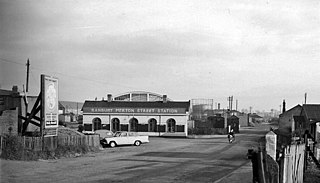
Banbury Merton Street was the first railway station to serve the Oxfordshire market town of Banbury in England. It opened in 1850 as the northern terminus of the Buckinghamshire Railway providing connections to Bletchley and Oxford and closing for passengers in 1961 and goods in 1966.
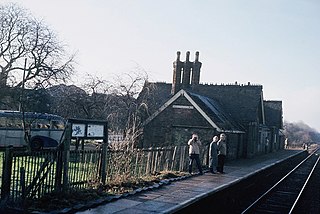
Winslow railway station refers to either one of two railway stations which historically served or is planned to serve, the town of Winslow in north Buckinghamshire, England. The original station (1850–1968) was on the former Varsity Line between Cambridge and Oxford. As of August 2023, construction of a new station nears completion and is scheduled to be served by East West Rail, as part of the plan to reinstate the Oxford–Cambridge service.

Swanbourne was a railway station that served the villages of Swanbourne, Little Horwood and Mursley in north Buckinghamshire, England. It was on the mothballed Bicester to Bletchley line, roughly at the centre of a triangle drawn between the three villages. In summer 2020, the station was demolished to clear the route for East West Rail.

The railway system of Buckinghamshire has a long and complex history dating back to the 1830s with the opening of sections of today's West Coast Main Line and Great Western Main Line. The development of Buckinghamshire's railway network was largely due to its position nationally as many long-distance routes chose to go through Buckinghamshire, especially between Britains two largest cities, London and Birmingham. The county had its own pulling power in addition, as produce such as the Aylesbury duck could then be easily transported to the capital.

Buckingham was a railway station which served Buckingham, the former county town of Buckinghamshire, England, between 1850 and 1966.
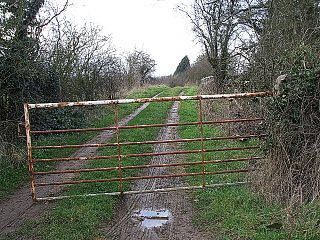
Radclive Halt was a railway station on the Banbury to Verney Junction Branch Line which served the village of Radclive in Buckinghamshire, England, from 1956 to 1961.
Water Stratford Halt was a railway station on the Banbury to Verney Junction Branch Line which served the village of Water Stratford in Buckinghamshire, England, from 1956 to 1961.

Transport in Buckinghamshire has been shaped by its position within the United Kingdom. Most routes between the UK's two largest cities, London and Birmingham, pass through this county. The county's growing industry first brought canals to the area, then railways and then motorways.

Farthinghoe was a railway station which served the Northamptonshire village of Farthinghoe in England. It opened in 1851 as part of the Buckinghamshire Railway's branch line to Verney Junction which provided connections to Bletchley and Oxford and closed in 1963.
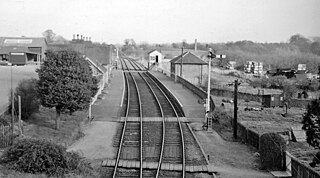
Brackley Town was a railway station which served the Northamptonshire town of Brackley in England. It opened in 1850 as part of the Buckinghamshire Railway's branch line to Verney Junction which provided connections to Banbury, Bletchley and Oxford and closed in 1963.

Padbury railway station served the village of Padbury in the English county of Buckinghamshire. It opened in 1878 as part of the Buckinghamshire Railway's branch line to Verney Junction which provided connections to Banbury, Bletchley and Oxford and closed in 1964.
The Banbury to Verney Junction branch line was a railway branch line constructed by the Buckinghamshire Railway which connected the Oxfordshire market town of Banbury with the former Oxford/Cambridge Varsity line and the former Metropolitan Railway at Verney Junction, a distance of 21 miles 39 chains. Onward routes from there ran to the West Coast Main Line at Bletchley via Brackley and Buckingham and thence to Cambridge, or to Aylesbury for London.
The Birmingham and Oxford Junction Railway was an English railway line promoted by the Great Western Railway to gain a route from its southern base towards the industrial centres of the West Midlands, and in due course the north-west. It overtook another GWR subsidiary, the unbuilt Oxford and Rugby Railway, and the Birmingham Extension Railway which was to build a new independent station in the city. It was authorised in 1846 and formed a single project to connect Birmingham and Oxford.

















